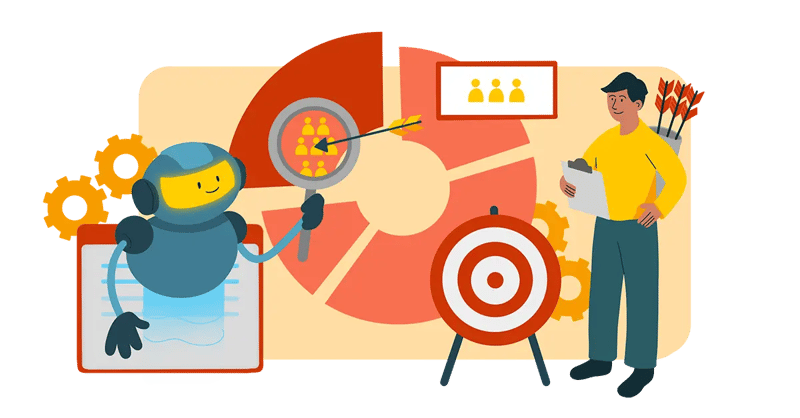Ce este CAC (costul de achiziție clienți) și cum îl îmbunătățești?
Implementarea unei strategii de marketing de succes necesită stăpânirea complexității costului de achiziție a clienților (CAC). CAC este o măsură care dezvăluie investiția financiară necesară pentru a achiziționa un nou client, servind drept ghid pentru întreprinderile care caută strategii eficiente de creștere.

Ce este costul de achiziție a clienților?
În esență, costul de achiziție a clienților (CAC) reprezintă toate cheltuielile asociate cu achiziționarea unui client. Acestea cuprind costurile legate de campaniile de marketing, publicitate, eforturile de vânzări și orice alte resurse dedicate procesului. Exprimarea CAC în termeni monetari oferă întreprinderilor o măsură tangibilă a investiției necesare pentru a transforma un prospect într-un client plătitor.
Importanța CAC constă în capacitatea sa de a oferi o perspectivă financiară clară asupra achiziției de clienți. Prin înțelegerea costului de achiziționare a fiecărui client, întreprinderile pot lua decizii în cunoștință de cauză cu privire la alocarea resurselor și la strategia de inbound marketing, asigurând o abordare echilibrată și durabilă a creșterii.
Pentru a prospera pe o piață concurențială, întreprinderile trebuie să meargă dincolo de metricile tradiționale și să pătrundă în complexitatea CAC. Acesta este un indicator fundamental al eficienței marketingului, dezvăluind eficacitatea diferitelor canale și campanii. Un CAC scăzut implică un raport cost-eficiență în achiziția de clienți, în timp ce un CAC ridicat poate semnala ineficiențe care necesită atenție.
În plus, înțelegerea CAC facilitează stabilirea unor obiective de venituri realiste. Prin alinierea așteptărilor privind veniturile la costul de achiziție a clienților, întreprinderile pot stabili obiective realizabile și pot promova o traiectorie de creștere mai durabilă. CAC acționează ca o busolă care ghidează întreprinderile către optimizarea eforturilor lor de marketing, asigurând un echilibru sănătos între cheltuieli și randamentul investițiilor.
Calcularea CAC
Calcularea costului de achiziție a clienților implică o abordare sistematică care permite întreprinderilor să cuantifice investiția necesară pentru a aduce un nou client în rețea.
-
Definiți cheltuielile: Începeți prin a identifica toate cheltuielile asociate cu achiziția de clienți. Acestea includ costurile legate de campaniile de marketing, publicitate, eforturile de vânzări și orice alte resurse dedicate atragerii și conversiei clienților.
-
Determinați intervalul de timp: Stabiliți cadrul temporal pentru calcul. Coerența este vitală pentru comparații semnificative și analiza tendințelor, fie lunar, trimestrial sau anual.
-
Numărați clienții noi: Urmăriți numărul de clienți noi achiziționați pe parcursul perioadei alese. Această cifră servește drept numitor în calculul CAC.
-
Aplicați formula: Utilizați formula CAC: CAC = Cheltuielile totale de marketing / Numărul de clienți noi dobândiți. Împărțiți cheltuielile totale la numărul de clienți noi pentru a obține costul mediu de achiziționare a unui client.
Pentru a vă ajuta să înțelegeți conceptul de CAC, luați în considerare următorul scenariu:
O companie investește 10 000 de dolari într-o campanie de marketing și dobândește 500 de clienți noi în perioada campaniei. CAC pentru această campanie ar fi calculat după cum urmează:

CAC ar costa 20 $ (10 000 $ / 500 clienți) în acest exemplu. Această formulă simplă oferă o cifră tangibilă care permite întreprinderilor să evalueze eficiența cheltuielilor lor de marketing în achiziția fiecărui client nou.
Un alt exemplu implică urmărirea CAC în timp. Să presupunem că o întreprindere cheltuiește în mod constant 50 000 de dolari pe marketing în fiecare lună și dobândește o medie de 1 000 de clienți noi lunar. CAC pentru această perioadă ar fi de 50 $(50 000 $ / 1 000 de clienți). Prin monitorizarea CAC pe parcursul mai multor luni, întreprinderile pot identifica tendințele și își pot ajusta strategiile de marketing în consecință.
Prin adoptarea CAC ca indicator-cheie de performanță, întreprinderile obțin informații valoroase care le permit să își rafineze abordarea și să aloce resursele mai eficient.
Acestea fiind spuse, există câteva capcane comune de care trebuie să se țină seama atunci când se calculează CAC:
-
Luarea în considerare incompletă a cheltuielilor: Asigurați-vă că toate cheltuielile relevante sunt luate în considerare, inclusiv cheltuielile generale asociate cu personalul, tehnologia și alte resurse.
-
Cadru temporal consecvent: Mențineți coerența cadrului temporal ales pentru a facilita comparațiile exacte. Cadrele temporale nepotrivite pot denatura calculele CAC și pot împiedica o analiză semnificativă.
-
Evitarea atribuirii greșite: Atribuiți cu exactitate cheltuielile eforturilor specifice de achiziționare a clienților. Atribuirea greșită poate duce la cifre inexacte ale CAC, întunecând înțelegerea eficienței marketingului.
Instrumentele avansate de analiză pot oferi informații detaliate cu privire la performanța canalelor individuale de marketing, a campaniilor și a segmentelor de clienți. Prin valorificarea datelor, întreprinderile pot identifica canalele cu performanțe ridicate, pot optimiza cheltuielile de marketing și își pot rafina continuu CAC.
În plus, analiza datelor permite întreprinderilor să efectueze analize de cohortă, examinând comportamentul și valoarea clienților achiziționați în anumite perioade. Acest nivel mai aprofundat de analiză sporește acuratețea evaluărilor CAC și ghidează întreprinderile în efectuarea de ajustări strategice ale strategiilor lor de achiziție de clienți.
Factori care influențează CAC
Înțelegerea costului de achiziție a clienților necesită o examinare nuanțată a diverșilor factori care influențează acest parametru esențial. De la canalele de publicitate la segmentarea clienților, întreprinderile trebuie să navigheze într-un peisaj format din diverse elemente care au un impact asupra eficienței și eficacității eforturilor lor de achiziționare a clienților.
Canalele de publicitate
Alegerea canalelor de publicitate joacă un rol semnificativ în determinarea CAC. Diferitele canale vin cu costuri și rate de conversie diferite. De exemplu, publicitatea plătită pe rețelele de socializare poate da rezultate diferite în ceea ce privește CAC față de marketingul pe motoarele de căutare sau campaniile de e-mail. Analizarea performanței fiecărui canal permite întreprinderilor să aloce resursele în mod strategic, concentrându-se pe canalele care asigură cea mai rentabilă achiziție de clienți.
În plus, natura concurențială a anumitor canale poate influența CAC. Pe piețele foarte saturate, războaiele de licitație pentru spațiul publicitar pot crește costurile, ceea ce face esențială evaluarea competitivității canalelor de către întreprinderi și ajustarea strategiilor în consecință.
Segmentarea clienților
Nu toți clienții sunt creați la fel, iar înțelegerea nuanțelor segmentării clienților este esențială în optimizarea CAC. Diferitele segmente de clienți pot avea costuri de achiziție și valori ale duratei de viață diferite. Prin clasificarea clienților pe baza datelor demografice, a comportamentelor sau a preferințelor, întreprinderile își pot adapta strategiile de marketing pentru a viza cu mai multă precizie segmentele cu valoare ridicată.
O segmentare eficientă permite întreprinderilor să își personalizeze mesajele, promoțiile și ofertele, crescând astfel probabilitatea de a dobândi clienți mai susceptibili de a se converti și de a contribui pozitiv la profit. Examinarea atentă a segmentelor de clienți permite întreprinderilor să optimizeze CAC prin adaptarea abordării lor la caracteristicile unice ale diferitelor publicuri țintă.
Forțele pieței externe
CAC nu este doar un parametru intern; forțele pieței externe îl influențează. Condițiile economice, tendințele din industrie și chiar fluctuațiile sezoniere pot avea un impact asupra costului de achiziție a clienților. În perioade de incertitudine economică, concurența s-ar putea intensifica, afectând costurile de publicitate și influențând ulterior CAC.
Monitorizarea factorilor externi permite întreprinderilor să își adapteze strategiile în mod proactiv. De exemplu, este posibil ca întreprinderile să fie nevoite să își ajusteze bugetele și tacticile de marketing în timpul sezoanelor de vârf sau al evenimentelor din industrie pentru a face față modificărilor CAC. Rămânând atente la dinamica pieței externe, întreprinderile își pot menține flexibilitatea și pot optimiza CAC în ciuda provocărilor externe.
Strategii pentru îmbunătățirea CAC
Întreprinderile trebuie să își rafineze în permanență strategiile pentru a spori eficiența și a reduce CAC. Prin implementarea unor abordări specifice și adoptarea unor metodologii bazate pe date, organizațiile își pot optimiza CAC, deschizând calea către o creștere durabilă.
Vizați clienții cu valoare ridicată
Nu toți clienții contribuie în mod egal la rezultatele finale, iar recunoașterea valorii segmentelor de clienți cu randament ridicat este esențială pentru îmbunătățirea CAC. Întreprinderile pot aloca resursele mai eficient prin identificarea și prioritizarea segmentelor de clienți cu o valoare pe durata vieții (LTV) mai mare. Adaptarea eforturilor de marketing pentru a rezona cu aceste segmente cu valoare ridicată îmbunătățește achiziția de clienți și maximizează randamentul investițiilor.
Utilizați abordări bazate pe date
Datele sunt un aliat puternic în încercarea de a îmbunătăți CAC. Prin valorificarea abordărilor de marketing bazate pe date, întreprinderile pot obține informații valoroase despre comportamentul clienților, preferințele și performanța diferitelor canale de marketing. Strategiile cheie includ:
-
Cartografierea parcursului clientului: Înțelegerea parcursului clientului ajută la optimizarea punctelor de contact și la eficientizarea drumului către conversie. Identificarea punctelor de fricțiune și a zonelor de îmbunătățire sporește eficiența generală a achiziției de clienți.
-
Testarea A/B: Experimentarea permite întreprinderilor să testeze diferite elemente ale campaniilor și strategiilor pentru a identifica ce rezonează cel mai bine cu publicul lor țintă. Testarea A/B oferă informații empirice pentru a ghida procesul decizional în vederea unei achiziții mai eficiente a clienților.
-
Modelarea atribuirii: Atribuirea precisă a conversiilor la anumite puncte de contact de marketing este esențială pentru înțelegerea impactului fiecărui canal asupra achiziției de clienți. Această perspectivă permite întreprinderilor să aloce bugetele mai eficient, concentrându-se pe canalele cu performanțe ridicate.
Îmbunătățiți retenția clienților pentru a reduce CAC
În timp ce achiziția de noi clienți este vitală, păstrarea clienților existenți este la fel de importantă pentru optimizarea CAC pe termen lung. Păstrarea clienților reduce nevoia de cheltuieli ridicate și continue pentru eforturile de achiziție. Strategiile de îmbunătățire a fidelizării clienților includ:
-
Comunicarea personalizată: Adaptarea comunicării la preferințele individuale ale clienților, promovând un sentiment de conexiune și loialitate.
-
Programe de loialitate: Stimulați repetarea afacerilor prin programe de fidelizare, încurajând clienții să rămână implicați și să facă achiziții recurente.
-
Asistență proactivă pentru clienți: Anticiparea și abordarea proactivă a nevoilor clienților sporește satisfacția și reduce probabilitatea de a renunța la servicii.
Instrumente și tehnologii pentru optimizarea CAC
Căutarea unui cost optim de achiziție a clienților implică utilizarea unor instrumente și tehnologii de ultimă oră care permit întreprinderilor să ia decizii bazate pe date și să își eficientizeze eforturile de marketing.
-
Google Analytics: Această platformă de analiză oferă o imagine cuprinzătoare a traficului pe site, a comportamentului utilizatorilor și a datelor de conversie. Prin utilizarea Google Analytics, întreprinderile pot identifica canalele cu performanțe ridicate, pot înțelege călătoriile clienților și își pot optimiza cheltuielile de marketing pentru a îmbunătăți CAC.
-
Sisteme de gestionare a relațiilor cu clienții (CRM): Sistemele CRM precum HubSpot permit întreprinderilor să centralizeze datele clienților, să urmărească interacțiunile și să obțină informații despre comportamentul clienților. Prin integrarea datelor CRM cu eforturile de marketing, întreprinderile pot personaliza campaniile, pot viza segmente cu valoare ridicată și pot spori eficiența CAC globală.
-
Platforme de automatizare a marketingului: Automatizarea eficientizează sarcinile repetitive, permițând marketerilor să se concentreze asupra inițiativelor strategice. Platformele de automatizare a marketingului permit comunicarea personalizată, hrănirea lead-urilor și campanii direcționate, îmbunătățind eficiența achiziției de clienți.
-
Instrumente de testare A/B: Experimentarea este esențială pentru rafinarea strategiilor de marketing. Instrumentele de testare A/B permit întreprinderilor să testeze variații ale campaniilor și să identifice cele mai eficiente elemente, ceea ce conduce la optimizarea CAC în timp.
-
Software de modelare a atribuirii: Atribuirea precisă este esențială pentru înțelegerea impactului fiecărui punct de contact de marketing asupra achiziției de clienți. Software-ul de modelare a atribuirii ajută companiile să aloce credite diferitelor canale, ghidând alocarea bugetului pentru îmbunătățirea CAC.
Automatizarea joacă un rol esențial în creșterea eficienței și reducerea volumului de muncă manuală. Prin automatizarea sarcinilor repetitive, întreprinderile pot raționaliza procesele de achiziție de clienți, pot îmbunătăți direcționarea campaniilor și pot realiza economii. Domeniile critice pentru automatizare includ:
-
Punctajul liderilor: Clasificarea automatizată a lead-urilor atribuie valori lead-urilor pe baza caracteristicilor și interacțiunilor acestora, permițând echipelor de vânzări să prioritizeze perspectivele cu potențial ridicat.
-
Campanii de e-mail: Instrumentele de automatizare a marketingului facilitează campaniile de e-mail personalizate și oportune, hrănind lead-urile și ghidându-le prin pâlnia de conversie.
-
Postarea și monitorizarea pe rețelele sociale: Instrumentele de automatizare permit întreprinderilor să programeze postări, să monitorizeze implicarea și să analizeze performanța, asigurând o prezență consecventă și optimizată în social media.
Rămânând la curent cu aceste instrumente și tehnologii, întreprinderile pot nu numai să optimizeze CAC în prezent, ci și să se poziționeze pentru succes în peisajul în continuă evoluție al achiziției de clienți. Încorporarea instrumentelor și tehnologiilor avansate asigură faptul că întreprinderile rămân agile, adaptabile și în prima linie a inovației în urmărirea eficienței CAC și a obiectivelor de marketing.
Acest conținut este disponibil și în:
- Germană: Was sind Kundenakquisitionskosten (CAC) und wie kann ich sie senken?
- Engleză: What is Customer Acquisition Cost (CAC), And How Do I Improve It?
- Spaniolă: ¿Qué es CAC (Costo Cliente) y Cómo Bajarlo?
- Franceză: Qu'est-ce que le coût d'acquisition client et comment l'améliorer?
- Italiană: Cos'è il CAC (costo acquisizione clienti) e come migliorarlo?
- Chineză: 客户获取成本是什么?我该如何降低它?

Joachim, un Trainer HubSpot certificat cu peste 13 ani de experiență în Content Marketing, Strategie, implementare de website-uri și SEO, a implementat numeroase proiecte de growth marketing internaționale la scară largă, de exemplu, cu UiPath de la stadiul de startup până la listarea la bursa NYSE (IPO). Joachim are o expertiză deosebită în proiecte de Marketing multilingv și Sales Enablement, valorificând pentru clienții noștri cele mai avansate tehnologii de inteligență artificială (AI).








Lasă un comentariu cu părerea ta.